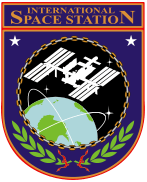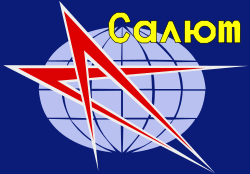Zvezda (ISS module)
 | |
| Station statistics | |
|---|---|
| Launch date: | July 12, 2000 |
| Launch vehicle: | Proton-K |
| Docked: | July 26, 2000 |
| Undocked: | Permanently Docked |
| Reentry: | TNB |
| Mass: | 20,320 kilograms (44,800 lb) [1] |
| Length: | 13.1 metres (43 ft) |
| Width: | 29.7 metres (97 ft) |
| Diameter: | 4.35 m [2] |
| References: [3][4][5] | |
| Configuration | |
 On-orbit configuration of the Zvezda service module | |
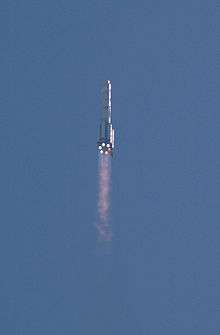
Zvezda (Russian: Звезда́, meaning "star"), DOS-8, also known as the Zvezda Service Module, is a component of the International Space Station (ISS). It was the third module launched to the station, and provides all of the station's life support systems, some of which are supplemented in the USOS, as well as living quarters for two crew members. It is the structural and functional center of the Russian portion of the station - the Russian Orbital Segment.
The module was manufactured by RKK Energia, with major sub-contracting work by GKNPTs Khrunichev.[6] Zvezda was launched on a Proton rocket on July 12, 2000 and docked with the Zarya module on July 26.
Origins
The basic structural frame of Zvezda, known as "DOS-8", was initially built in the mid-1980s to be the core of the Mir-2 space station. This means that Zvezda is similar in layout to the core module (DOS-7) of the Mir space station. It was in fact labeled as "Mir-2" for quite some time in the factory. Its design lineage thus extends back to the original Salyut stations. The space frame was completed in February 1985 and major internal equipment was installed by October 1986.
The MIR-2 space station was redesigned after the failure of the Polyus orbital weapons platform core module to reach orbit. Zvezda is around 1/4 the size of Polyus, and has no armaments.
Design
Zvezda consists of the cylindrical "Work Compartment" where the crews work and live (and which makes up the bulk of the modules volume), the small spherical "Transfer Compartment" located at the front (with three docking ports), and at the aft end the cylindrical "Transfer Chamber" (with one docking port) which is surrounded by the unpressurized "Assembly Compartment" – this gives Zvezda four docking ports in total.[6] The component weighs about 18,051 kg (39,796 lb) and had a length of 13.1 metres (43 ft). The solar panels extend 29.7 metres (97 ft).
The "Transfer Compartment" attaches to the Zarya module, and has docking ports intended for the Science Power Platform and the Universal Docking Module. As in the early days of Mir, the transfer compartment provides a suitable EVA airlock where spacewalkers in Orlan suits removed a hatch after closing a few that connected the compartment to the rest of the station. It was used only during Expedition 2, where two men put a docking cone on the nadir port. The lower port connects to Pirs and the top port connects to Poisk. Eventually, the plan for Pirs is for it to be deorbited and replaced by the Multipurpose Laboratory Module.
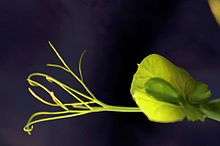
The "Assembly Compartment" holds external equipment such as thrusters, thermometers, antennas, and propellant tanks. The "Transfer Chamber" is equipped with automatic docking equipment and is used to service Soyuz and Progress spacecraft.
Zvezda can support up to six crew[6] including separate sleeping quarters for two cosmonauts at a time.[6] It also has a NASA-provided Treadmill with Vibration Isolation System and a bicycle for exercise, a toilet and other hygiene facilities and a galley with a refrigerator and freezer. The module contains the primary Russian computers for guidance and navigation.
Zvezda has 14 windows[6]— There are two 9-inch-diameter (230 mm) windows, one in each of the two crew sleep compartments (windows No. 1 and 2). Six 9-inch-diameter (230 mm) windows (No. 3, 4, 5, 6, 7 and 8) on the forward Transfer Compartment earth facing floor. As well a 16-inch-diameter (410 mm) window in the main Working Compartment (No. 9) and one 3-inch-diameter (76 mm) window in the aft transfer compartment (No. 10). There are a further three 9-inch-diameter (230 mm) windows in the forward end of the forward transfer compartment (No. 12, 13 and 14), for observing approaching craft. Note: Window No. 11 is unaccounted for in all available sources.
Zvezda also contains the Elektron system that electrolyzes condensed humidity and waste water to provide hydrogen and oxygen. The hydrogen is expelled into space and the oxygen is used for breathing air. The condensed water and the waste water can be used for drinking in an emergency, but ordinarily fresh water from Earth is used. There are 16 small thrusters and two large S5.79 thrusters for propulsion. The oxidizer used for the propulsion system is dinitrogen tetroxide and the fuel is UDMH, the supply tanks being pressurised with nitrogen.[8] Additionally, it has eight batteries for storing power. The Elektron system has required significant maintenance work, having failed several times and requiring the crew to use the Solid Fuel Oxygen Generator canisters (also called "Oxygen Candles", which were the cause of a fire on Mir) when it has been broken for extended amounts of time. It also contains the Vozdukh, a system which removes carbon dioxide from the air based on the use of regenerable absorbers of carbon dioxide gas. Zvezda has been criticized for being excessively noisy and the crew has been observed wearing earplugs inside it.
Zvezda contains the ESA's Digital Management System, a computer that controls ISS.[9]
Zvezda is also the home of the Lada Greenhouse, which is a test for growing plants in space.[10]
Connection to the ISS

The rocket used for launch to the ISS carried advertising; it was emblazoned with the logo of Pizza Hut restaurants,[11][12][13] for which they are reported to have paid more than US$1 million.[14] The money helped support Khrunichev State Research and Production Space Center and the Russian advertising agencies that orchestrated the event.[15]
On July 26, 2000, Zvezda became the third component of the ISS when it docked at the aft port of Zarya. (Zarya had already been attached to the U.S. Unity module.) Later in July, the computers aboard Zarya handed over ISS commanding functions to computers on Zvezda.[16]
On September 11, 2000, two members of the STS-106 Space Shuttle crew completed final connections between Zvezda and Zarya; during a 6-hour, 14 minute EVA, astronaut Ed Lu and cosmonaut Yuri Malenchenko connected nine cables between Zvezda and Zarya, including four power cables, four video and data cables and a fiber-optic telemetry cable.[17] The next day, STS-106 crew members floated into Zvezda for the first time, at 05:20 UTC on September 12, 2000.[18]
Zvezda provided early living quarters, a life support system, a communication system (Zvezda introduced a 10 Mbit/s Ethernet network to the ISS[19]), electrical power distribution, a data processing system, a flight control system, and a propulsion system. These quarters and some, but not all, systems have since been supplemented by additional ISS components.
The two main engines on Zvezda can be used to raise the station's altitude. This was done on April 25, 2007. This was the first time the engines had been fired since Zvezda arrived in 2000.[20]
Launch risks
Due to Russian financial problems, Zvezda was launched with no backup and no insurance. Due to this risk, NASA had constructed an Interim Control Module in case it was delayed significantly or destroyed on launch.
Interior
 Zvezda's space toilet
Zvezda's space toilet Forward view of interior of Zvezda
Forward view of interior of Zvezda Part of the Galley
Part of the Galley

Crew
 Crewmembers celebrating Christmas in Zvezda
Crewmembers celebrating Christmas in Zvezda View of one of the Zvezda crew quarters
View of one of the Zvezda crew quarters Cosmonaut in Zvezda, November 2000.
Cosmonaut in Zvezda, November 2000. Expedition 37 crew in Zvezda
Expedition 37 crew in Zvezda
Exterior
 Zvezda service module under construction
Zvezda service module under construction PMA-2, Unity Node 1, PMA-1, Zarya FGB, Zvezda Service Module, and Progress M1-3.
PMA-2, Unity Node 1, PMA-1, Zarya FGB, Zvezda Service Module, and Progress M1-3.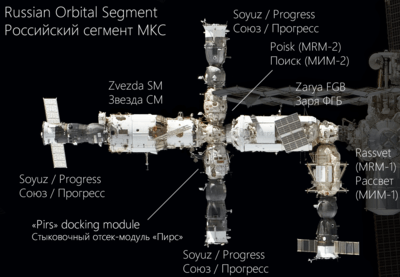 The location of Zvezda in the Russian Orbital Segment
The location of Zvezda in the Russian Orbital Segment Sunrise in orbit overlooking Zvezda and its solar array
Sunrise in orbit overlooking Zvezda and its solar array Russian Orbital Segment Windows
Russian Orbital Segment Windows
Dockings

- Aft Port
- Progress M-29M 61P, 2015 - 2016
- Soyuz TMA-16M 2015 [21]
- Georges Lemaître ATV 2014-2015
- Progress M-21M 2013-2014
- Soyuz TMA-09M 2013[22]
- Albert Einstein ATV-4 2013
- Progress M-17M 49P, 2012-2013
- Edoardo Amaldi ATV-3 2012
- Progress M-11M 43P, 2011
- Johannes Kepler ATV-2 2011
- Progress M-07M 39P, 2010
- Progress M-06M 38P, 2010
- Soyuz TMA-19 2010[22]
- Soyuz TMA-17 2010
- Progress M-04M 36P, 2010
- Soyuz TMA-16 2009-2010
- Progress M-67, 34P, 2009
- Jules Verne ATV-1 2008
- Progress M-65 30P, 2008
- Progress M-60 25P, 2007

- Progress M-58 23P, 2006-2007
- Soyuz TMA-9 2006
- Soyuz TMA-7 2006
- Progress M-56 21P, 2006
- Progress M-54 19P, 2005-2006
- Progress M-53 18P, 2005
- Progress M-52 17P, 2005
- Progress M-51 16P, 2004-2005
- Progress M-50 15P, 2004
- Progress M-49 14P, 2004
- Progress M1-11 13P, 2004
- Progress M-48 12P, 2003-2004
- Progress M-47 10P, 2003
- Progress M1-9 9P, 2002-2003

- Progress M-46 8P, 2002
- Progress M1-8 7P, 2002
- Progress M1-7 6P, 2001-2002
- Progress M-45 5P, 2001
- Progress M1-6 4P, 2001
- Progress M-44 3P, 2001
- Progress M1-3 1P, 2000 (1st)
- Nadir
- Pirs 2001–Present
- Zenith
- Poisk 2009–Present
- Forward
- Zarya, 2000–Present
References
- ↑ "Archived copy". Archived from the original on September 26, 2015. Retrieved November 8, 2015.
- ↑ "Служебный модуль "Звезда"".
- ↑ "The ISS to Date". NASA.gov. 2007-02-22. Retrieved 2007-06-24.
- ↑ "International Space Station Status Report #06-7". NASA.gov. 2006-02-17. Retrieved 2007-06-24.
- ↑ "NASA - Zvezda Service Module". NASA.gov. 2006-10-14. Retrieved 2007-07-10.
- 1 2 3 4 5 Zvezda @ RuSpace
- ↑ ISS Images - ISS006-E-45076 (17 March 2003)
- ↑ Anatoly Zak (18 June 2013). "Zvezda service module (SM)". Retrieved 8 April 2016.
- ↑ ESA - ISS docks successfully with Zvezda module (2000)
- ↑ Nasa.gov, October 20, 2005. http://www.nasa.gov/missions/science/f_lada.html. Accessed July 01, 2015
- ↑ Space.com, September 30, 1999. Pizza Hut Puts Pie in the Sky with Rocket Logo. Accessed June 27, 2006. Archived January 14, 2006, at the Wayback Machine.
- ↑ SpaceDaily, July 8, 2000. Proton Set to Make Pizza Delivery to ISS. Accessed May 5, 2013.
- ↑ Geere, Duncan (November 2, 2010). "The International Space Station is 10 today!". Wired.co.uk. Wired.co.uk. Retrieved 20 December 2014.
- ↑ "THE MEDIA BUSINESS; Rocket to Carry Pizza Hut Logo". New York Times. October 1, 1999. Retrieved January 21, 2009.
- ↑ SpaceDaily - Proton Set to Make Pizza Delivery to ISS (2000)
- ↑ "STS-106". NASA.
- ↑ "STS-106 Report # 07". NASA.
- ↑ "STS-106 Report # 10". NASA.
- ↑ ISS and STS Commercial Off-The-Shelf Router Testing Archived February 26, 2009, at the Wayback Machine., Ivancic, Bell and Shell, NASA Technical Memo TM-2002-211310
- ↑ "International Space Station Status Report: SS07-23". NASA.
- ↑ "Soyuz Relocation". NASA. Retrieved 29 Aug 2015.
- 1 2 NASA - Soyuz Move Sets Stage for Arrival of New Crew
External links
- Zvezda @ RuSpace (includes diagrams)
